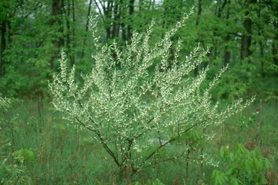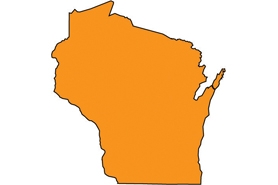Autumn olive
(Elaeagnus umbellata)
Large deciduous shrub with silvery foliage. Autumn olive grows up to 20' tall. Small silvery scales cover twigs.
Other names for this plant include:
- Common names: Autumn elaeagnus, oleaster, silverberry, spreading oleaster
- Scientific names: E. crispa; E. umbellata car. parvifolia; E. parvifolia
Classification in Wisconsin: Restricted
- Ecological Threat
-
- Autumn olive invades open and forested natural areas, roadsides, and agricultural fields.
- It thrives in high-light conditions where it can produce numerous fruits.
- Alters nutrient cycling by adding nitrogen to the soil.
- Identification
-
Leaves: Simple and alternate. Autumn olive leaves are dark green on top and silver-gray on the underside, lance-shaped or elliptic, with entire, wavy margins. It has a gray-green hue when seen from a distance.
Flowers: Tube- or bell-shaped, fragrant, and borne in leaf axils. Bloom in late spring. Autumn olive flowers are creamy-white to light yellow.
Fruits & seeds: Fruits of the autumn olive are small, fleshy, egg-shaped and pink to red with silver scales. Birds disperse seeds.
Roots: Associated with nitrogen-fixing bacteria. Cutting or other damage causes root suckering.
Similar species: Russian olive; invasive (Elaeagnus angustifolia) is a tree that can reach 30' with twigs with a terminal spine. Russian olive's leaves are silver on both sides, longer and more lance-shaped and the flowers are yellow inside and silver outside. Fruits of Russian olive are yellow, dry and olive-like. This aggressive invader prefers open areas, including wet areas; it uses water more quickly than native species and can dry out riparian areas.
Two native buffaloberries, silver (Sheperdia argentea) and russet (S. canadensis) have silvery foliage but their leaves are opposite.
- Control
-
Mechanical: Pull seedlings. Cutting, mowing, and burning are not recommended because plants will resprout unless followed up with chemical control.
Chemical: Treat foliage, cut surface, or girdled stems with glyphosate, triclopyr ester, or metsulfuron-methyl with a surfactant. Basal bark application of triclopyr ester can also be practical. Treat foliage with a liquid spray during the active growing season. For cut stump or girdled bark treatment, use liquid herbicide by painting, dripping, or sponging onto a surface.
- Resources
- Sources for content:
- USDA Forest Service, Northeastern Area Forest Health Staff. Weed of the Week: Autumn Olive [exit DNR]
- Hilty, John. Illinois Wildflowers. Weedy Wildflowers of Illinois – Autumn Olive [exit DNR] (Elaeagnus umbellata).


